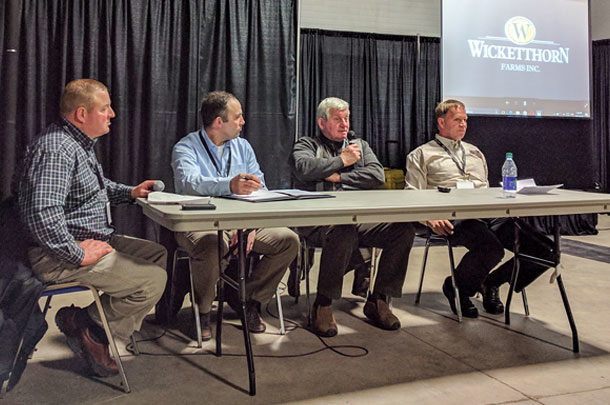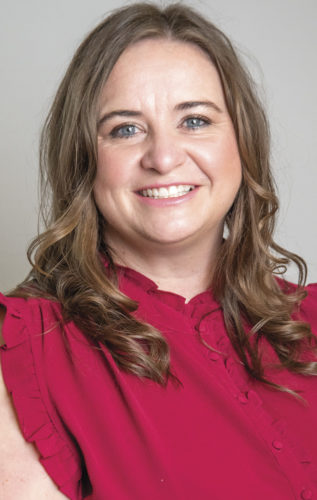Three dairy industry leaders shared their experiences with expansion on Feb. 9 at the London Dairy Congress in London, Ontario, during a panel presentation.
Craig Connell, Wicketthorn Farms, London, Ontario; John Van Ginkel, Embro Farm Systems Inc., Embro, Ontario; and Glen Sim, Glenbert Holsteins Inc., Embro, Ontario, come from different backgrounds but share a vision of growth for the future.
Moderated by Dave Johnson, Nuview Farms, Thorndale, Ontario, here is what the panelists had to say and their answers to the questions posed.
- Wicketthorn Farms is a family-run operation managed by Craig Connell, his wife, their son and his son’s wife, with the help of part-time and full-time staff.
After moving from Scotland in 1981, they settled in the London area on a 48-cow tiestall farm and have grown over the years to where they now milk 360 cows, farm 1,700 acres (half-owned and half-rented) and raise more than 1,900 beef cattle.
Now in a six-row freestall barn and milking in a rotary parlour, they also moved to bunk silos from the original upright silos and use a liquid manure system. They feed calves with three automatic feeders in three rooms that hold 40 calves each.
Recent additions include a grain setup with an electric grinder to store 40 to 50 tonnes in overhead bins, and they just purchased a new truck-mounted mixer.
Additionally, in 2002, they bought an old feedlot; however, after years of runoff issues and adding lean-tos, they changed to a fabric-covered structure with a capacity of 2,000 head of beef cattle.
- Embro Farm Systems Inc. is a farmstead and farm automation dealer founded in 1987 by brothers John and Tyx Van Ginkel and John’s wife, Johanne.
Outgrowing their original 24’ by 40’ garage in Embro, Ontario – without room for expansion – in 1999 they bought a dairy in Burgessville, when Westfalia bought Surge Dairy Equipment, and called it Performance Dairy Centre.
Then, in 2000, they bought a 10-acre property with 18,000 square feet where Performance Dairy Centre is located today in Embro. In 2013, they purchased the neighbouring plant with 8 acres and 26,000 square feet and moved Embro Farm Systems over in January 2015.
Recently, in early 2017, due to succession planning, they split Performance Dairy Centre and Embro Farm Systems into two separate businesses.
- Glenbert Holsteins Inc. is a fourth-generation family farm managed by Glen, his son Jackson (14) and daughter Olivia (11), along with evening high school help.
Glen’s parents passed on the farm in 2003 with 30 milking cows, which has increased to 75 head today.
They farm 250 acres of forages and grains and operate in a tail-to-tail tiestall barn that is full at 62 stalls including an additional 15 milking cows housed on a straw pack.
Their calves are raised in hutches and fed milk for 90 days until they are moved to another barn, where they are fed grass hay and free-choice calf starter and water.
Glen tries to have growth every year with shipping more milk and, with his children’s keen interest in the farm, he is now starting to look into the future to incorporate the next generation.
Do you have a five- to 10-year plan?
CONNELL: We don’t have a written plan, but we certainly spend more time looking ahead than we are looking back. We’ve always been in the growing and expansion mode and don’t know anything else.
We’ve always believed that you need to be growing at about 10 percent a year to run a successful business.
VAN GINKEL: If we didn’t have road maps, we’d never get to where we are going. Whether it is written or not written, you need to have a plan. There is no neutral in farming or in business. If you think there is a neutral, then you’re going backwards.
SIM: We’re always trying to move forward and be more efficient and, if nothing else, make it a more pleasurable and easier job. We want to make it appealing to the next generation to make them want to be involved and take over.
How can you get more out of your existing facilities?
CONNELL: I’ve built a lot of lean-tos in my time, to add on and to get a little bit more here and a little bit more there. With the next generation coming on, there is certainly a long-term future in it, so we’ve went away from building lean-tos to building something more substantial.
We are maxed out now; if we want to expand on the livestock side, we need to build more buildings.
VAN GINKEL: We can all walk in our own forest and not see the trees. There is a wealth of information out there, but we usually have to ask for it or look for it.
I’ve seen some of the best ideas come out of a contractor or equipment dealer. It’s great to go to open houses, but I think it is even greater to go to the neighbour or customer and ask them one-to-one.
SIM: We are maxed out full. As some of these quota incentives come along, I would maybe crowd my heifers a bit more to give more room to cows in box stalls.
I know it is only a short-term solution, but milk is a pretty nice cash flow. Another way to make it more efficient at our place is to keep our milk components high and fill more quota with less cows, and at the odd time, I have fresh 2-year-olds for sale.
What was the biggest roadblock in expansion?
CONNELL: Manpower. We’ve got another generation coming on, and most of them have shown interest in farming, so that in itself has given me a lot of pleasure and enthusiasm to keep growing.
But really, when you get to the size we are at, we must have good-quality staff. We have to have the staff lined up before we start doing more expanding.
VAN GINKEL: Staff is always hard to come by, even though it is in our business or on the farm. I hear that it is not so much qualified people – but willing. That is something we all have to face, and hopefully we can move forward on that.
The other roadblock in this dairy industry is that we used to always hear nothing but, “I bought quota – can’t buy this and can’t buy that” or “I can’t buy quota,” but in the last year and a half that has totally changed.
Our board is doing a lot better than they did about 10 years ago. That is why we are where we are, and that is why the industry has got some room to expand.
There is a lot of room to expand, but are we ready for this? Are we willing to move forward? Because somebody in the world is going to fill that need.
SIM: Our next expansion roadblock would be to move or build another facility, and it’s going to be a huge capital cost. I guess we need to get ready for that to be able to take on all that debt.
Are you surrounded by enough infrastructure to service your farm efficiently?
CONNELL: As far as service, we are well positioned but would appreciate if we could get natural gas, high-speed internet or three-phase hydro – that would certainly help.
VAN GINKEL: In our case, it is location, location, location. I must admit, there are a lot of good spots in Ontario, but we are definitely in a good spot. I do see some areas where the dairy farms have totally left and, therefore, the infrastructure left the area too.
SIM: We are in a prime agriculture area, and all of our services are close. I don’t have to worry about city limits near me, so as far as looking to move, that’s not in my sights.
How do you work with your team and whom do you involve on that team?
CONNELL: We would count our team as the veterinarian, nutritionist, agronomist, accountant and banker – we consult with all of them.
When it comes to the vet and agronomist, we don’t need to know the chemical breakdown of everything they are using, we just need to know what they’ll do for us and what it will cost.
We sit down with the accountant a couple of times a year and make sure things are headed the right way, and we’ll have a major discussion with the banker at least once a year.
VAN GINKEL: In the past, I’ve seen a lot of farms use their dealers as their credit, and that day is history. As dealers, our money is usually out of the bank account before the equipment even hits the yard.
Your relationship with the banker is very important, as it is with your accountant, because it’s not about $100,000 any more, it’s about millions. Being proactive instead of reactive is what the bankers and the accountant are looking for.
SIM: Vets and agronomists have more details than most of us even understand, but if they can tell you what it is going to do for you and what it’s going to cost, those are the kind of guys I like to deal with.
I ask our barn equipment dealer every now and again, and he’ll give it to me pretty straight. It’s good to have other eyes look at your operation and tell you where you can improve.
We talk with our banker and accountant twice a year to go over long- and short-term plans to try to keep everything running smoothly.
Although these panelists manage different operations within the dairy industry, they share a positive perspective on sustainable growth and planning for the future. ![]()
PHOTO: Panelists address the topic of farm expansion at the 2017 London Dairy Congress in London, Ontario. From left to right, moderator Dave Johnson, Nuview Farms, and panelists; Glen Sim, Glenbert Holsteins Inc.; Craig Connell, Wicketthorn Farms; and John Van Ginkel, Embro Farm Systems. Photo by Lora Bender.

-
Lora Bender
- Editor
- Progressive Dairyman
- Email Lora Bender









